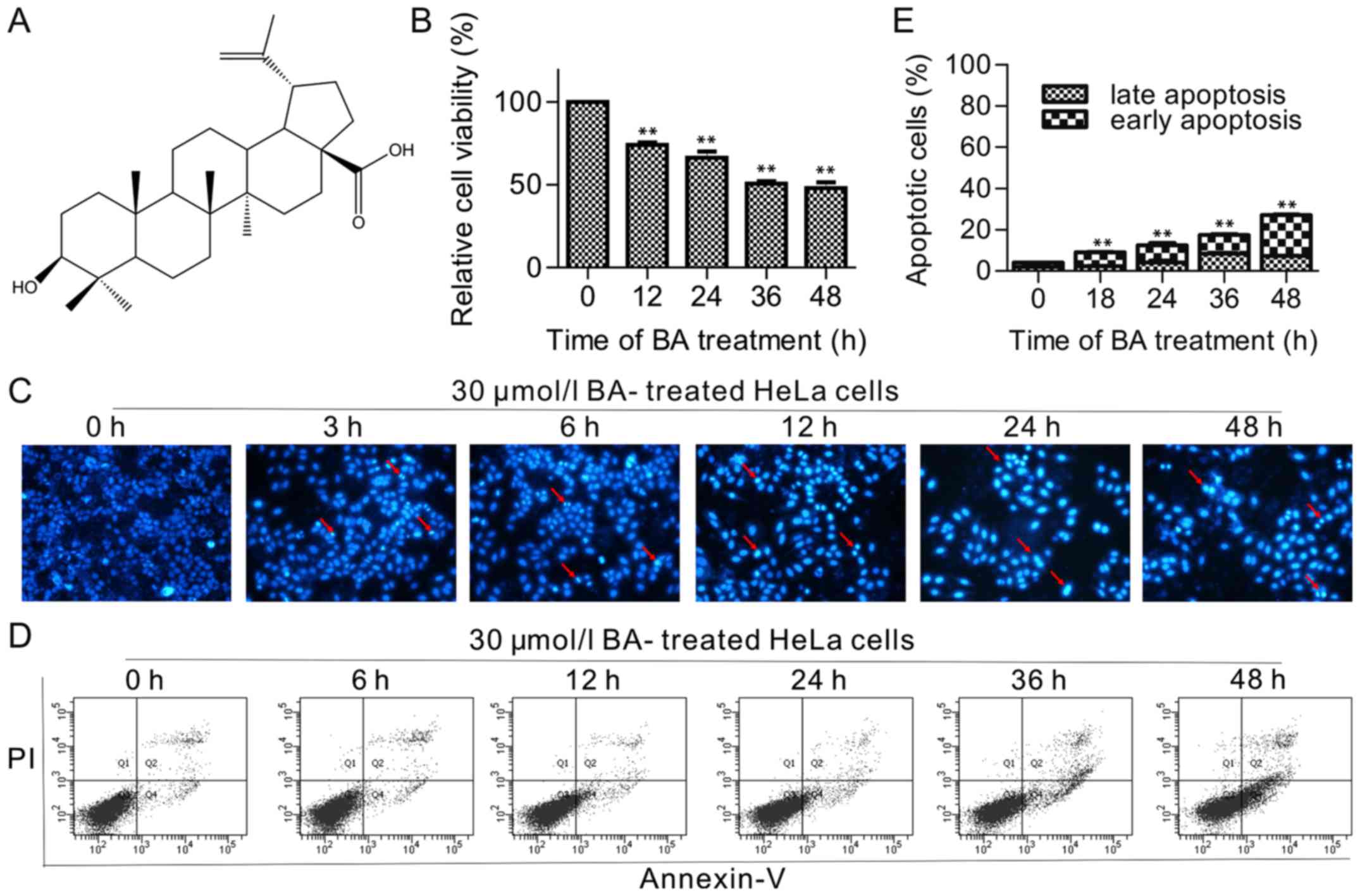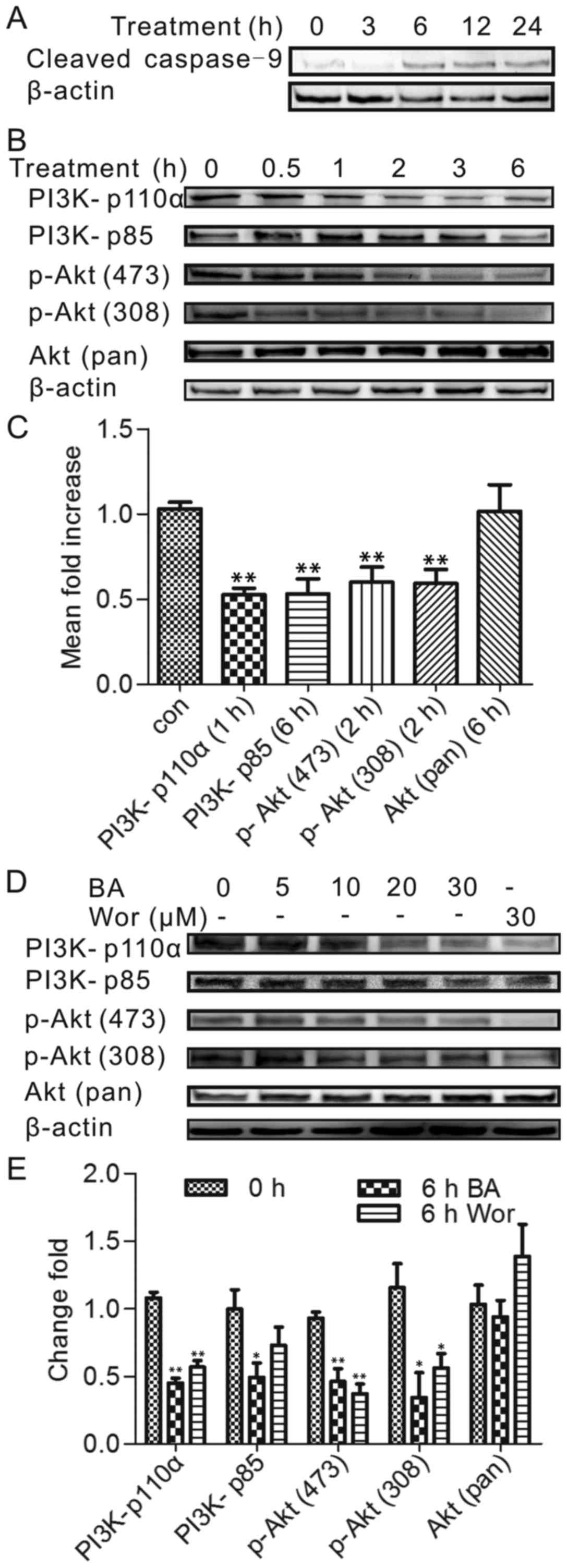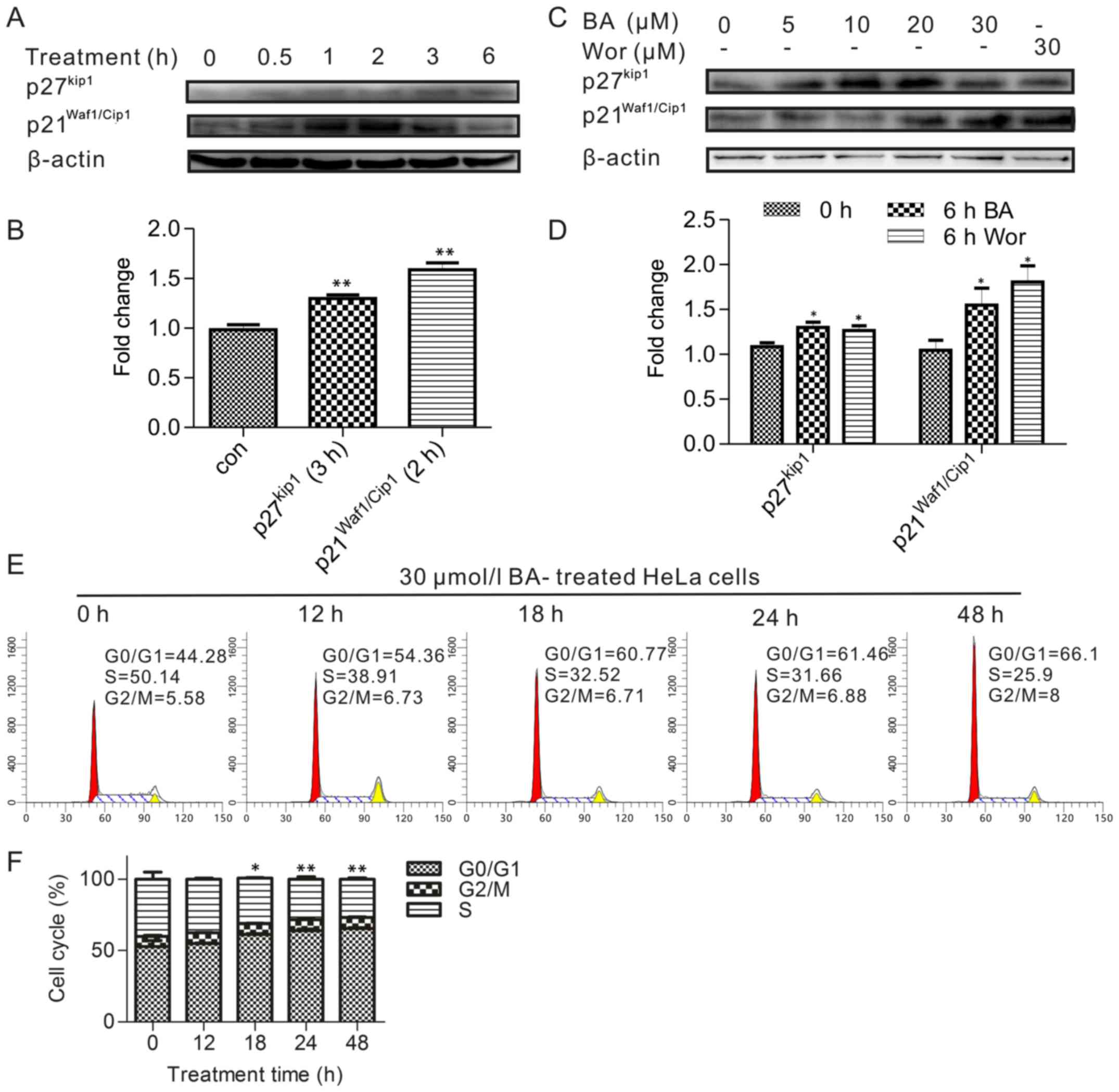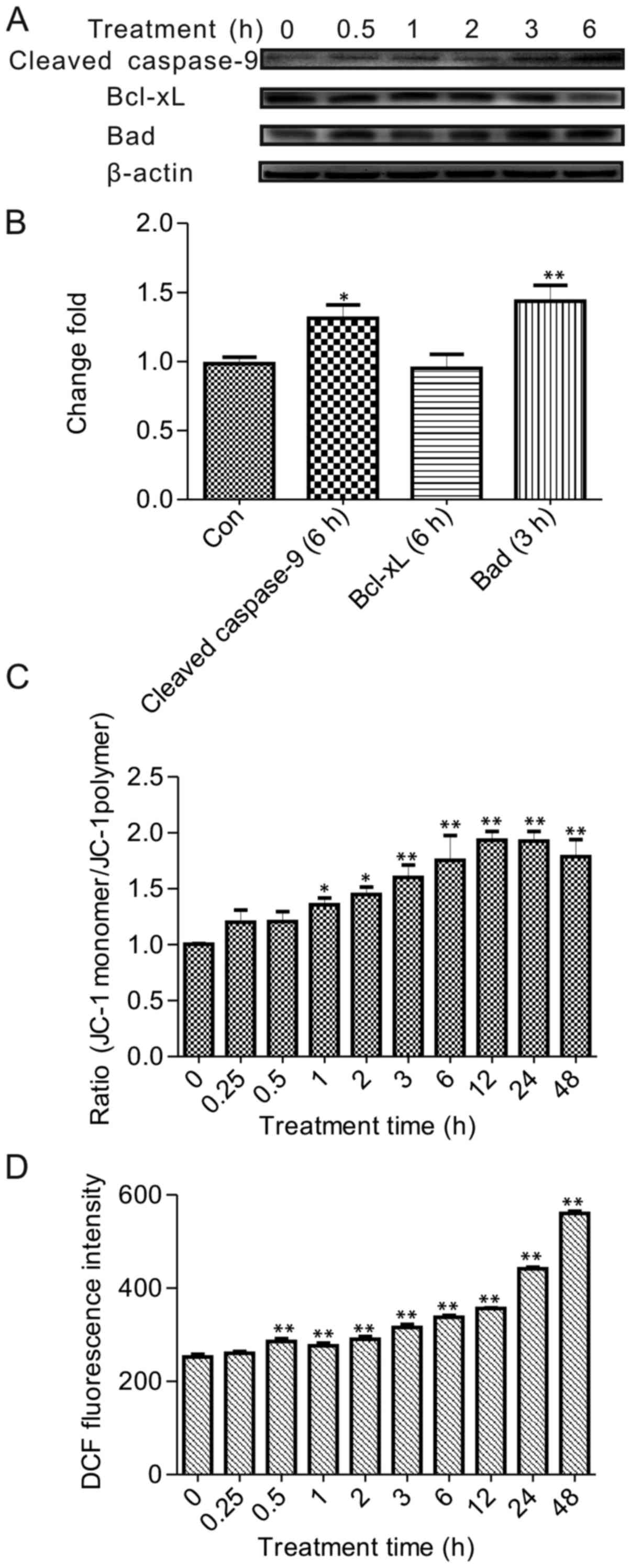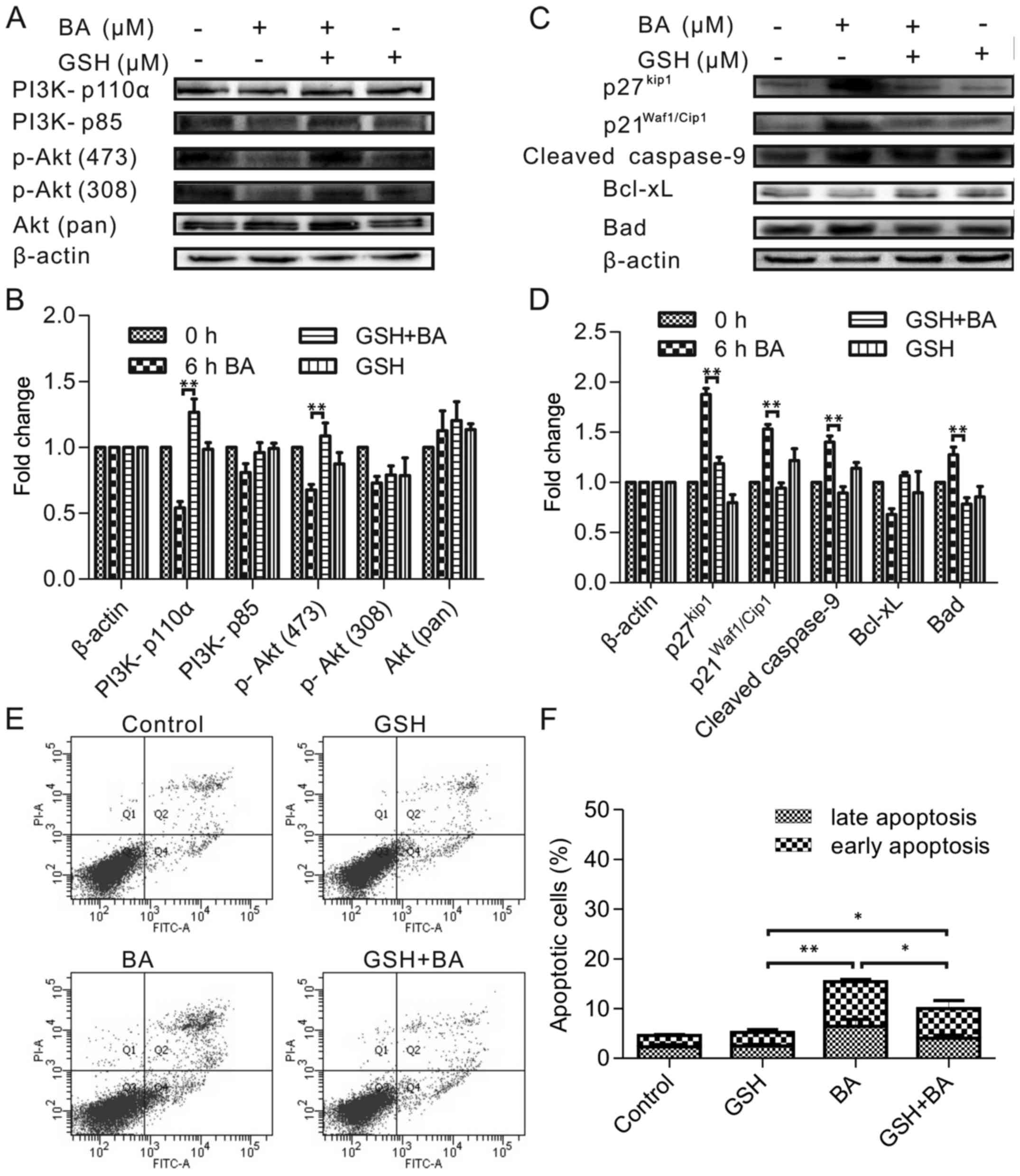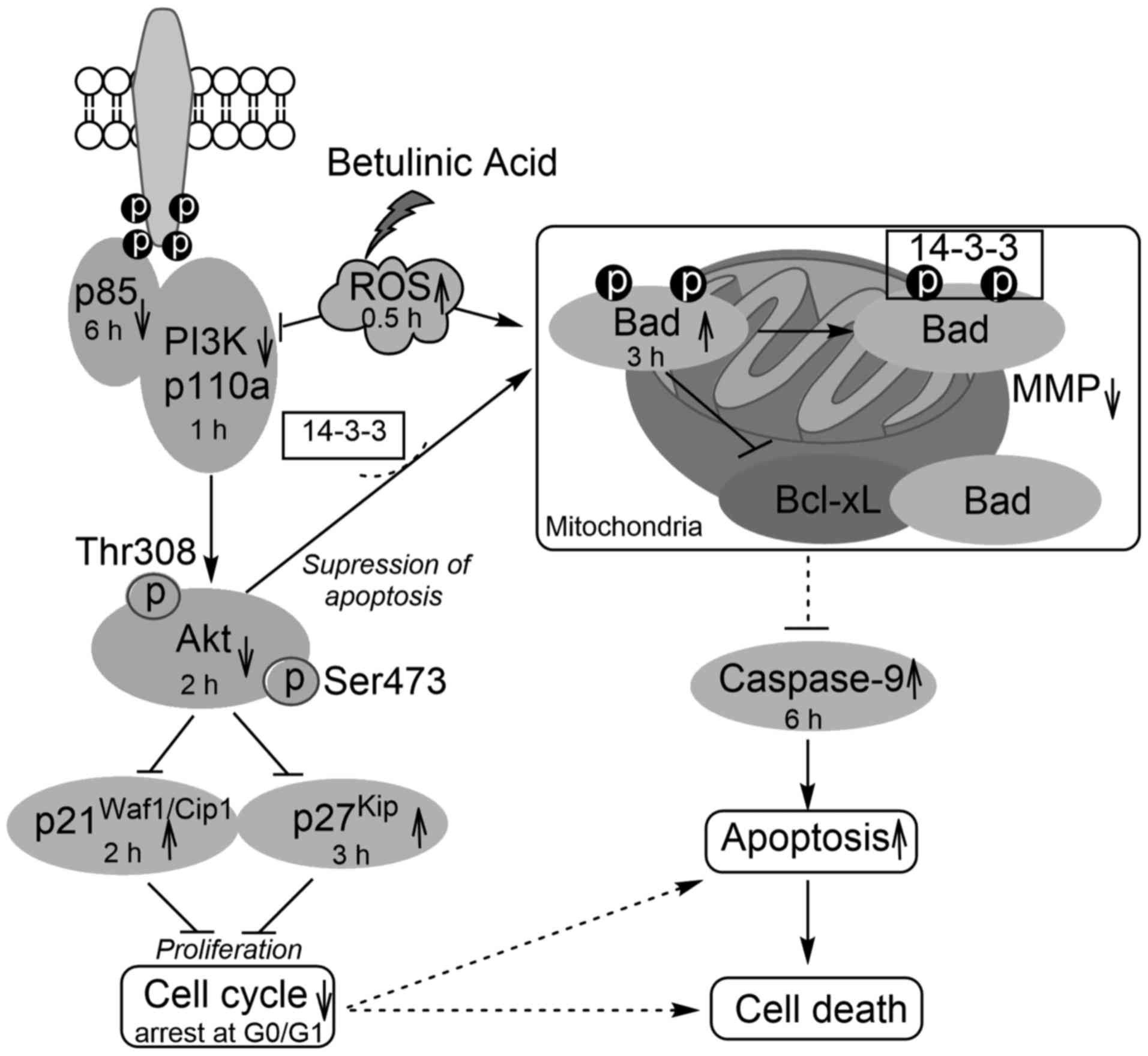Betulinic acid induces apoptosis by regulating PI3K/Akt signaling and mitochondrial pathways in human cervical cancer cells
- Authors:
- Published online on: September 28, 2017 https://doi.org/10.3892/ijmm.2017.3163
- Pages: 1669-1678
-
Copyright: © Xu et al. This is an open access article distributed under the terms of Creative Commons Attribution License.
Abstract
Introduction
Betulinic acid (BA) (Fig. 1A) is a naturally occurring lupane-type triterpene found in the bark of white birch trees, and it is one of the most promising lead compounds for new cancer therapeutics (1). BA has been introduced as a potential anticancer compound against a wide variety of cancer cells such as leukemia, prostate, ovarian, breast, lung and hepatoblastoma (2–5). This anticancer activity has been linked to its ability to directly trigger mitochondrial membrane permeabilization independent of p53, a central event in the apoptotic process in many cancer cells (6–8). However, the mechanism by which BA induces apoptosis in human cervical cancer has yet to be fully elucidated.
Triterpenoids have been reported to induce cell cycle arrest and apoptosis via modulation of the phosphatidylinositol 3-kinase (PI3K)/Akt pathway (9), which is an intracellular signaling pathway important in regulating several cellular processes. Activation of the PI3K/Akt pathway has been shown to promote cellular survival in a vast of cancer cells, because it can inhibit the cell cycle progression by repressing downstream factors: p27Kip and p21Waf1/Cip1 belong to cyclin-dependent kinase (10,11). At the same time, it also can modulate apoptosis by phosphorylating and inactivating several targets, like Bad and caspase-9, that have important roles in mitochondrial apoptosis pathways (12). Apoptosis induced by BA involves activation of caspases, was suggested to depend on the mitochondrial pathway, therefore, the authors hypothesized that the PI3K/Akt pathway may involve in the apoptosis process by BA induction (13).
In a previous study, it was demonstrated that BA can induce apoptosis activity in HeLa by proteomic (14), but the molecular mechanisms behind its function are still not fully understood. In the present study, the authors attempted to evaluate the mechanistic role of BA in a cervical cancer cell line (HeLa) by exploring its effects on apoptosis and the cell cycle. In addition, they attempted to investigate the important signaling network, such as the PI3K/Akt signaling pathway and the mitochondrial pathway involved in BA treatment in HeLa cells. The aim of the present study was to better understand the apoptosis mechanism induced by BA.
Materials and methods
Antibodies and reagents
BA powder was purchased from Shanghai Boyle Chemical Co., Ltd. (Shanghai, China) and dissolved in dimethylformamide. Primary antibodies were purchased from Cell Signaling Technology, Inc. (Danvers, MA, USA): anti-PI3K p85 (cat. no. 4257), anti-PI3K p110a (cat. no. 4249), anti-Akt (cat. no. 4691), anti-phospho-Akt (Thr308) (cat. no. 2965), anti-phospho-Akt (Ser473) (cat. no. 4060), anti-Bcl-xL (cat. no. 2764), anti-Bad (cat. no. 9292), anti-caspase-9 (cat. no. 9501), anti-p21Waf1/Cip1 (cat. no. 2947), anti-p27Kip (cat. no. 2552) and anti-β-actin (cat. no. 4970). Peroxidase-conjugated goat anti-rabbit IgG (H+L) was from Santa Cruz Biotechnology, Inc. (Dallas, Texas, USA) and SuperSignal West Femto Maximum Sensitivity Substrate from Thermo Fisher Scientific, Inc. (Waltham, MA, USA). Wortmannin and reduced L-glutathione (GSH) was purchased from Sigma-Aldrich; Merck KGaA (Darmstadt, Germany).
Cell culture
The human cancer cell line HeLa was purchased from the Tumor Center (Beijing Yinzijing Biological Company, Beijing, China). Cells were cultured in RPMI-1640 medium (HyClone; GE Healthcare Life Sciences, Chalfont, UK) with 10% fetal bovine serum (FBS; GE Healthcare Life Sciences), 100 U/ml penicillin and 100 µg/ml streptomycin (HyClone; GE Healthcare Life Sciences). Cells were seeded in 6-, 12- and 96-well microplates and then incubated at 37°C in 5% CO2. The control group was HeLa cells with a corresponding concentration of DMF, such as 30 µmol/l BA corresponding control group is 0.15% DMF in medium. The concentration of probe drug is 20 mmol/l.
Cell proliferation assay (MTT assay)
Cells (2×104/ml) were seeded in 96-well microplates and then incubated at 37°C in 5% CO2. At 24 h, the medium was removed and replaced with fresh medium containing various concentrations of BA for various periods of time. Next, 30 µl of 3 mg/ml MTT (Amresco, Inc., Framingham, MA, USA) in phosphate-buffered saline (PBS) was added to each well, and then the plate was further incubated for 4 h. The remaining supernatant was removed, and 150 µl DMSO was added to each well and mixed thoroughly to dissolve the formazan crystals that formed. After 10 min incubation, the absorbance of each well was read at 490 nm using a BioTek-ELISA plate reader (BioTek Instruments, Inc., Winooski, VT, USA).
Detection of morphological changes
To detect morphological changes that occurred during apoptosis process, nuclear staining was performed using a 5 µg/ml Hoechst 33258 (Sigma-Aldrich; Merck KGaA) stain, and samples were visualized using a Nikon fluorescence microscope (Eclipse Ti-S; Nikon Corp., Tokyo, Japan).
Flow cytometry analysis of cell apoptosis
BA-induced apoptosis was observed by Annexin V-fluorescein isothiocyanate (FITC)/propicium iodide (PI) staining (Beyotime Institute of Biotechnology, Haimen, China) according to the manufacturer's instructions. Flow cytometry (BD FACSCanto; BD Biosciences, Franklin Lakes, NJ, USA) was used to analyze differences in apoptosis between control and BA-treated for various periods of time cells at 48 h post treatment. Cells were collected and analyzed by counting normal cells, early-stage apoptotic cells and late-stage apoptotic/necrotic cells in three fields of view of the microscope. The data acquisition and analysis were performed using BD FACSDiva software (version A, BD FACSCanto; BD Biosciences, Franklin Lakes, NJ, USA).
Western blot assay
HeLa cells (1.7×105) were seeded in 6-well microplates before treatment with BA or wortmannin (a specific inhibitor of PI3K) at the concentration of 30 µmol/l for 6 h time period. Wortmannin was used as a positive control here. Cells were collected and lysed in RIPA buffer (Beyotime Institute of Biotechnology) with PhosSTOP phosphatase inhibitor cocktail tablets (Roche Diagnostics, Indianapolis, IN, USA). Equal amounts of protein (30 µg/lane) by Bradford were separated by 12% sodium dodecyl sulfate-polyacrylamide gel electrophoresis (SDS-PAGE) and transferred to a polyvinyli-dene difluoride membrane (EMD Millipore, Billerica, MA, USA). After blocking in 5% non-fat milk and washing, the blots were incubated overnight at 4°C with specific primary antibodies diluted to 1:1,000 following the CST protocol. The membrane was washed three times with Tris-buffered saline (containing 1% Tween-20), and then incubated with secondary antibodies (peroxidase-conjugated goat anti-rabbit IgG (H+L) diluted to 1:8,000 for 1 h, followed with the same washing steps as above. Then, the immunoreactive proteins were visualized using the enhanced chemiluminescence reagent. Image Lab software (version 3.0; Bio-Rad, Hercules, CA, USA) was used to quantify of proteins using β-actin as a loading control. Changed fold was represented by the protein expression ratio [(target protein/β-actin)/the control group].
Measurement of oxidative stress
The levels of intracellular ROS were determined using a ROS assay kit (Beyotime Institute of Biotechnology) following the manufacturer's protocol. Cells were harvested after various periods of time (0–48 h) of 30 µmol/l BA treatment and then washed twice with PBS and incubated with DCFH-DA (10 µmol/l) at 37°C for 40 min in a darkroom for final analysis by flow cytometry.
Measurement of mitochondrial membrane potential (MMP)
MMP was determined using JC-1 probe (Beyotime Institute of Biotechnology) as described previously (15). Briefly after treating the cells with 30 µmol/l BA for various periods of time (0–48 h), cells were stained with 0.5 mg/ml of the fluorescence probe JC-1 for 20 min at 37°C. After washing, cells were analyzed for the decrease in red/green fluorescence by flow cytometry. The mitochondrial membrane potential is indicated by a decrease in red/green fluorescence intensity ratio.
Cell cycle analysis
HeLa cells were harvested via trypsin after 30 µmol/l BA for different time treatment, washed with PBS and fixed with 70% ethanol at 4°C for overnight. After washing twice with PBS, cells were stained with cell cycle analysis kit (Beyotime Institute of Biotechnology) containing propidium iodide (PI) and RNase A for 30 min in the dark at room temperature, as described previously (16). The DNA contents for cell cycle phase distribution were analyzed by Modfit LT 3.2 software (Verity Software House, Topsham, ME, USA).
ROS inhibitor treatment
In order to investigate the contribution of ROS in BA induced apoptosis, GSH, a ROS scavenger, was used as an ROS inhibitor. HeLa cells were seeded in 6-well plates (1.7×105 cells/well) for 24 h, then pre-incubation GSH for 1 h before treatment with 30 µmol/l BA for 6 h, the changes and the percentage of apoptotic cells were examined by flow cytometry, as described above. In parallel, western blotting of proteins in PI3K/Akt pathway experiments were accomplished.
Statistical analysis
The data were presented as mean ± standard deviation and the results were taken from at least three independent experiments. The statistically significant differences were determined using one-way analysis of variance by SPSS software (version 17.0; SPSS, Inc., Chicago, IL, USA). P<0.05 was considered to indicate a statistically significant difference.
Results
BA inhibited proliferation and induced apoptosis in HeLa cells
The antiproliferative activity induced by BA in HeLa cells was evaluated by an MTT assay. To identify the beginning of apoptosis and morphological changes for further experiment, the authors used flow cytometry and fluorescence microscopy to detect the HeLa cells after incubation with BA (30 µmol/l) in a series of time ranging up to 48 h.
The cell viability, as indicated by an MTT assay, displayed a general decline with increasing duration (12, 24, 36 and 48 h) of treatment with 30 µmol/l BA (Fig. 1B), suggesting that BA inhibited the cell viability of HeLa in a dose-dependent manner; and the IC50 was 66.75±1.73 µmol/l, 39.75±2.16 µmol/l and 30.42±2.39 µmol/l when HeLa cells were treated with BA for 24, 36 and 48 h, respectively (the IC50 was >100 µmol/l for a 12 h BA treatment). In order to examine the effect of BA-induced apoptosis in HeLa cells, the typical morphology of apoptosis was detected in BA-treated HeLa cells in more time points, (3, 6, 12, 24 and 48 h), as presented in Fig. 1C, the cell counts significantly declined following 12 h. To confirm that the reduction in the cell numbers was reflective of cell death, flow cytometric detection was performed using labeled Annexin V-FITC/PI, did not show a significant change until 12 h of incubation (little change at 6 h). The total percentage of apoptotic cells was 9.53±1.46% (7.2±1.14% of cells in early apoptosis and 2.33±0.25% of cells in late apoptosis), 13.10±1.45% (9.03±1.22% of cells in early apoptosis and 4.07±1.76% of cells in late apoptosis), 18.97±2.25% (9.90±1.30% of cells in early apoptosis and 9.10±1.00% of cells in late apoptosis) and 25.38±3.42% (18.01±3.38% of cells in early apoptosis and 7.36±0.21% of cells in late apoptosis) for cells treated with 30 µmol/l BA for 12, 24, 36 and 48 h, respectively (Fig. 1D and E).
Effect of BA on the expression of PI3K and phosphorylated Akt
To investigate the involvement of the PI3K/Akt pathway which plays an important role for cell survival and apoptosis, the authors performed a time-dependence study in which HeLa cells were incubated with BA for times ranging from 0–6 h. To select the treatment time for the western blot experiments, the caspase-9 expression was tested firstly, which is a well-established role in the process of mitochondrial apoptosis (16). The expression level of caspase-9 was identified by western blot analysis at a series of time points (0, 1, 3, 6, 12 and 24 h), as Fig. 2A shown, after stimulation with 30 µmol/l BA for 6 h, the cleaved caspase-9 expression was prominently increased. Therefore, before 6 h treatment time including 6 h was chosen to figure out the PI3K/Akt factors in HeLa incubated with BA because the caspase family activation is relative late in apoptosis process.
The expression level of PI3K (p110a), PI3K (p85), phospho-Akt (Ser473) and phospho-Akt (Thr308) was detected by western blotting after BA treatment at 0, 0.5, 1, 2, 3 and 6 h. As presented in Fig. 2B and C, PI3K (p110a) protein level was reduced significantly in BA-treated HeLa cells after 1 h of incubation (P<0.05) and the extent of protein activation decreased over time. Consistently, the phospho-Akt (Ser473) and phospho-Akt (Thr308) levels after 2 h and the PI3K (p85) level after 6 h significantly changed, indicating that PI3K (p110a) was an upstream regulatory factor that regulated other proteins. The above sequence of BA-induced inhibition was PI3K (p110a) 1 h, phospho-Akt (Ser473) 2 h, phospho-Akt (Thr308) 2 h, PI3K (p85) 6 h; interestingly, the phosphorylation of p85 was repressed by BA later than phospho-Akt (Ser473), phospho-Akt (Thr308). However, the expression of PI3K (p110a) was still blocked by BA in the beginning, which also can influence the downstream factors: Phospho-Akt (Ser473), phospho-Akt (Thr308) in BA treatment.
To further evaluate the dose-dependent study, a separate set of experiments was performed to determine the above protein activation effected by various concentrations (0, 5, 10, 20 and 30 µmol/l) of BA for 6 h incubation. As shown in Fig. 2D and E, although some proteins showed a fluctuating trend when treated with a small dose, there still had a significant change at 30 µmol/l BA treatment. In addition, the authors compared the potency of BA with wortmannin, the inhibitor of PI3K. The observation was the similar to the effect by BA on HeLa cells, suggesting that the PI3K/Akt pathway was involved in BA- induced HeLa apoptosis.
Upregulation of p21 and p27 and the inhibition of the cell cycle in BA-treated HeLa cells
The above results indicated the PI3K/Akt pathway involved in BA induced apoptosis, and the cell cycle is one of the most important processes regulated by the PI3K/Akt signaling pathway for cancer cell proliferation. Therefore, this part was to detect the cell cycle whether involved in BA induction. Treatments of durations were also applied for measuring the expression of p21Waf1/Cip1 and p27Kip proteins, which are important role in inhibition of cell cycle and regulated by Akt. As presented in Fig. 3A, the expression of p27Kip and p21Waf1/Cip1 has an increasing trend, and significantly respective went up after 3 and 2 h in duration results (Fig. 3B), whereas the level of p21Waf1/Cip1 phosphorylation reached a plateau and began to decrease after 2 h, indicated a transient phosphorylation pattern in this process. On the other hand, the level of p27Kip did not change until 3 h treatment by BA. The result was consistent with the fact that p21Waf1/Cip1 and p27Kip were substrates of the PI3K/Akt pathway because the activation time of p21Waf1/Cip1 and p27Kip was later than pAkt. Conversely, BA treatment of HeLa cells caused a drastic upregulation in the expression of p27Kip at 10, 20 µmol/l BA for 6 h treatment (Fig. 3C and D).
At the same time, the cell cycle was then analyzed by flow cytometry after the cells were treated with 30 µmol/l BA for various periods ranging up to 48 h. The authors observed that the number of cells in the S and G2/M phases decreased, and 18–48 h treatment time caused a dramatically increased G0/G1 phase population compared with in the control group (Fig. 3E and F). Therefore, this result suggested that BA arrested HeLa cells in the G0/G1 phase after the inhibition of the PI3K/Akt pathway depending on the response time.
BA induced mitochondrial-dependent apoptosis and disrupted the mitochondrial membrane potential (MMP) in HeLa cells
Subsequently, we explored whether this effect of BA was associated with an activation of mitochondrial pathway, which was modulated though PI3K/Akt regulated the process of pro-apoptotic factors, such as the Bcl-2 family and caspase-9.
To investigate the relationship between mitochondrial pathway and the PI3K/Akt pathway, as well as the effect of MMP influenced by BA, we examined the expression level of landmark target caspase-9 and Bad, Bcl-xL which were regulated by Akt. The results demonstrated that 30 µmol/l BA treatment promoted the expression of Bad after 3 h. Unexpectedly, there were no differences in the level of Bcl-xL, but the ratio of Bcl-xL/Bad protein expression was reduced by BA treatment. This result may have simply been a transposition and needs further investigation (16). Consistently for Bcl-xL, no alterations in expression levels have been reported upon exposure to BA in other cancer cells (17). Detectable cleavage products of caspase-9 clearly increased after 3 h in a time treatment trail (Fig. 4A and B). Therefore, this finding indicated that mitochondrial pathway took the initiative to regulate the apoptosis by BA treatment.
The role of the mitochondrial permeability transition (PT) pore was essential in apoptosis signaling. Opening of the PT pore resulted in membrane depolarization and finally lead to cell apoptosis. In the present study, the HeLa cells were treated with 30 µmol/l BA and subsequently stained with JC-1 to test the effect of PT depolarization by BA. JC-1 predominantly existed in monomeric form in cells with depolarized mitochondria and displayed green fluorescence. If with polarized mitochondria, JC-1 primarily formed aggregates in cells and showed reddish-orange fluorescence. The green and the red fluorescence gradually changed, with the green fluorescence significantly increasing during the treatment (data not shown). Changes in the ratio of JC-1 forms (monomeric form/aggregate form) were analyzed and graphically documented to demonstrate significant changes at 1 h with 30 µmol/l BA treatment (Fig. 4C). Strikingly, in HeLa cell, it was clearly observed that BA triggered the PT pore in a time-dependent way.
BA induced intracellular ROS generation
These observations indicated ROS scavenging probably involved in apoptosis induced by BA because the mitochondrial depolarization was always affected by ROS. To clarify whether ROS was related to the mitochondrial pathway, the ROS generation was detected using an oxidation-sensitive fluorescent dye, DCFH-DA, to determine the starting ROS generation time. As demonstrated in Fig. 4D, ROS generation was enhanced in a time-dependent manner with BA treatment, and the initiation of ROS production had a significant 1.2-fold increase compared to the control at 30 min. Furthermore, the trend was rising at the treatment time and arrived 1.5-fold compared to the control group at 48 h. Combined with above results, ROS generation was initiated earlier than MMP decrease, which suggested that ROS was upstream to regulate the apoptosis by BA, at least in HeLa cells.
Antioxidants prevented PI3K and Akt phosphorylation and apoptosis induction
The authors assessed the potential ability of PI3K/Akt to protect HeLa cells from apoptosis, focusing on its interventions upstream and downstream of ROS events. To unravel the molecular mechanism involved in ROS accumulation and explore the relationship between the ROS and the PI3K/Akt pathway, GSH (ROS inhibitor) was used to pretreatment of HeLa cells before treatment with 30 µmol/l BA for 6 h. According to the previous result, 6 h was the appropriate time because the expression of tested proteins had changed by BA treatment at 6 h. As Fig. 5A and B shown the GSH prevented the BA-induced inhibition of PI3K (p110a) and phospho-Akt (Ser473), meanwhile this change in the PI3K and Akt phosphorylation pattern correlated with the effects on other downstream substrates (p27Kip, p21Waf1/Cip1) and mitochondrial proteins (cleaved caspase-9, Bad) comparison with control cells (Fig. 5C and D). Therefore, these results suggested that ROS was upstream factor that could regulate the PI3K/Akt signaling pathway and the mitochondrial pathway.
To further ascertain the relevance between apoptosis and ROS, we pre incubated HeLa cells with 30 mM GSH before the 30 µmol/l BA treatment for 24 h. As presented in Fig. 5E and F, the apoptosis of cells treated with GSH before BA was inhibited significantly (P<0.05) compared to the positive control just incubated with GSH.
These results supported that ROS was an important factor for regulating the PI3K/Akt signaling pathway and the mitochondrial pathway involved in the BA-induced apoptosis mechanism.
Discussion
The aim of the present study was to elucidate the molecular mechanisms of apoptosis effects of BA and explore the specific cellular targets or signaling pathways in HeLa cells. As noted in previous studies, BA could induce HeLa apoptosis (14); however, the molecular mechanisms of this process are not fully understood.
A concentration of 30 µmol/l BA was chosen for subsequent treatments of HeLa cells to study the apoptosis initiation by BA. Different screening methods demonstrated that BA exhibited a cytotoxic activity in a time-dependent manner in the present study. The growth of the HeLa cells was significantly inhibited after 12 h treatment (Fig. 1B), and the typical morphology of apoptosis was also showed after 12 h treatment (Fig. 1C). Meanwhile, 12 h was the apoptosis initiation time of HeLa cells exposed to 30 µmol/l BA because it caused a significant increase of apoptosis cells at 12 h (Fig. 1D and E). Therefore, 12 h is a critical treatment time to induce inhibition, and it was assumed that the relevance factors involved in apoptosis process should be activated by BA before 12 h.
BA appears to target the mitochondrial PT pore directly in most previous results (6), thus, the authors firstly figured out the expression level of cleavage caspase-9 to find an appropriate monitor time for other proteins, because the caspase-9 is crucial for mitochondrial pathway and its activation is relative later than other proteins. As Fig. 2A indicated, after 6 h treatment with 30 µmol/l BA, the expression of cleaved caspase-9 was prominently increased, thus, before and including 6 h treatment time was chosen to detect the PI3K/Akt signaling factors.
The PI3K/Akt signaling pathway represents an important anticancer target especially for mitochondrial apoptosis because the regulation of mitochondrial respiratory activities was affected by Akt through protein translation pathway (15,18,19). Growth factors and hormones trigger a PI3K phosphorylation event, which, in turn, coordinates cell growth, cell cycle entry, cell migration and cell survival (20). In addition, the PI3K pathway exerts its function through the downstream molecule Akt to regulate various cell functions, including cell proliferation, cell transformation, cell apoptosis, tumor growth and angiogenesis (20). Given the significant role of PI3K/Akt in cancer cells, the authors determined whether BA treatment changed the PI3K expression and the phosphorylation status of Akt in HeLa cells.
Western blotting was used to verify phosphorylation of PI3Ks' catalytic subunit (p110) and an adapter subunit (p85), which induces the phosphorylation of Akt at two key regulatory sites: Threonine 308 (Thr308) and serine 473 (Ser473) (21). These proteins were inhibited in does- and time-treatment (Fig. 2). Although some proteins showed a fluctuating trend when treated with a small dose, Fig. 2C and D still suggested that BA could inhibit the PI3K/Akt signaling pathway in a relative does- dependent manner in early time.
The Akt protein modulates cyclin-dependent kinase inhibitors, p27Kip and p21Waf1/Cip1, that inhibit cell cycle progression (22). In addition, Akt has been implicated as an anti-apoptotic factor in many different cell death processes (e.g., Akt regulates the apoptotic machinery and inactivates proapoptotic proteins, such as Bad, which controls the release of cytochrome c from mitochondria) (12,23). Therefore, the authors designed two parts to measure the cell cycle and mitochondrial pathway.
For cell cycle part, as shown in Fig. 3A and B, although the protein expression continuously increased with time, the BA treatment of HeLa cells caused a drastic upregulation in the expression of p21Waf1/Cip1 and p27Kip proteins after the inhibition of the phosphorylation of pAkt (Fig. 3A); this finding is consistent with the fact that p21Waf1/Cip1 and p27Kip are substrates of the PI3K/Akt pathway (24). The flow cytometry result indicated that BA arrested HeLa cells in the G0/G1 phase after the inhibition of the PI3K/Akt pathway; this finding is in line with the protein expression profile of p21Waf1/Cip1 and p27Kip can arrest cell proliferation at the G1/S transition (25). Actually, numerous lines of evidence have indicated that anticancer drugs induce tumor regression through the induction of cell cycle arrest and/or apoptosis (26,27), and Kang et al (28) also proved that the PI3K/Akt pathway is involved in the apoptosis process by thioridazine. The present observations suggested that the inhibition of the PI3K/Akt pathway by BA in HeLa cells led to cell cycle arrest.
At the same time, in the apoptotic process, the mitochondrial pathway is a central event that seals the cell's fate, and it is particularly important for BA-induced apoptosis (6,29). BA has been reported to induce apoptosis via direct mitochondrial perturbations of Bcl-2 family proteins, such as antiapoptotic Bcl-xL and proapoptotic Bad (29,30). As noted in the authors' previous studies, the 14-3-3 protein was inhibited in HeLa cells by BA (14), and the interaction between Bad and 14-3-3 causes Bad to be retained in the cytoplasm, thus preventing Bad from dimerizing with Bcl-xL at the mitochondria and mediating the release of Bax from Bcl-xL. Moreover, the PI3K/Akt signaling pathway phosphorylates Bad at Ser155 in the BH3 domain that plays a critical role in blocking the dimerization of Bad and Bcl-xL (17,31). Therefore, Bad and Bcl-xL were measured to evaluate the relationship among these proteins by western blotting for treatments of durations. Because of caspase-9 significantly increasing after 6 h (Fig. 4), the authors also examined caspase-9 influenced by Akt because previous research demonstrated the involvement of the PI3K/Akt pathway in the suppression of the cytochrome c-induced processing of pro-caspase-9 and reduced caspase activity (32).
To better understand the effectiveness of BA in targeting the mitochondria of HeLa cells, alterations in the MMP were directly determined. Loss of MMP is a near-universal hallmark and a critical step for subsequent cell death (3,33). Thus, the result (Fig. 4C and D) showed that the mitochondria pathway was involved in the effects of the BA treatment of HeLa cells. At the same time, ROS played an important role in apoptosis induction because it is involved in MMP and cell death induction (34,35). Hence, the generation of ROS was monitored. Combined with activation time point, the decrease in MMP started from 1 h of treatment after the generation of ROS 0.5 h, confirming that the loss of MMP may be due to an increased ROS level. These data illustrated the role of BA in enhancing ROS and inducing apoptotic death in HeLa cells. The generation of ROS, which induced disruption of mitochondrial function with a concurrent loss of MMP, was important for the BA-treatment effects on HeLa cells.
The results described above suggested that ROS played a prominent role in BA-induced apoptosis and that PI3K/Akt was also influenced by BA at an early time. Therefore, we then investigated the relationship between ROS and the PI3K/Akt signaling pathway. GSH is the key antioxidative regulator of intracellular redox status and is commonly used to antagonize the effects of ROS or to protect against programmed cell death (36,37). Therefore, GSH was selected to investigate the importance of ROS in the apoptosis process mediated by BA. Western blot results supported that ROS was an important upstairs factor for regulating the PI3K/Akt signaling pathway and the mitochondrial pathway, as Fig. 5 indicated, PI3K (p110a), phospho-Akt (Ser473), p27Kip, p21Waf1/Cip1, caspase-9 and Bad were protected by GSH. At the same time, GSH could prevent HeLa cells apoptosis that supposes that ROS was a critical regulator for apoptosis in BA treatment (Fig. 5E and F). These results supported the view that PI3K/Akt signaling and the mitochondrial pathway were regulated by ROS and acted in opposition in the balance of cell survival and death.
In conclusion, BA showed a strong inhibitory effect on HeLa cell growth at pharmacological concentration (30 µmol/l). The present study confirmed that BA-induced apoptosis involved the inhibition of PI3K (p110a and p85), presented the deregulation of the Akt signaling pathway in response to the generation of ROS, indicated that there is a decrease in the mitochondrial potential, the activation of mitochondrial-regulated Bad, caspase-9 and the cell cycle regulators p27Kip and p21Waf1/Cip1 and the induction of G0/G1 phase arrest (Fig. 6). These insights may be helpful to understand the molecular mechanism of the BA antitumor effect in HeLa cells and to enhance the development of BA for clinical use.
Acknowledgments
The present study was financially supported by the Fundamental Research Funds for the Central Universities (grant no. DL13EA02).
References
|
Pisha E, Chai H, Lee IS, Chagwedera TE, Farnsworth NR, Cordell GA, Beecher CW, Fong HH, Kinghorn AD, Brown DM, et al: Discovery of betulinic acid as a selective inhibitor of human melanoma that functions by induction of apoptosis. Nat Med. 1:1046–1051. 1995. View Article : Google Scholar : PubMed/NCBI | |
|
Zuco V, Supino R, Righetti SC, Cleris L, Marchesi E, Gambacorti-Passerini C and Formelli F: Selective cytotoxicity of betulinic acid on tumor cell lines, but not on normal cells. Cancer Lett. 175:17–25. 2002. View Article : Google Scholar | |
|
Kroemer G, Galluzzi L and Brenner C: Mitochondrial membrane permeabilization in cell death. Physiol Rev. 87:99–163. 2007. View Article : Google Scholar : PubMed/NCBI | |
|
Rabi T, Shukla S and Gupta S: Betulinic acid suppresses constitutive and TNFalpha-induced NF-kappaB activation and induces apoptosis in human prostate carcinoma PC-3 cells. Mol Carcinog. 47:964–973. 2008. View Article : Google Scholar : PubMed/NCBI | |
|
Eichenmüller M, von Schweinitz D and Kappler R: Betulinic acid treatment promotes apoptosis in hepatoblastoma cells. Int J Oncol. 35:873–879. 2009.PubMed/NCBI | |
|
Tan DF, Li Q, Rammath N, Beck A, Wiseman S, Anderson T, al-Salameh A, Brooks J and Bepler G: Prognostic significance of expression of p53 oncoprotein in primary (stage I–IIIa) non-small cell lung cancer. Anticancer Res. 23:1665–1672. 2003.PubMed/NCBI | |
|
Mullauer FB, Kessler JH and Medema JP: Betulinic acid induces cytochrome c release and apoptosis in a Bax/Bak-independent, permeability transition pore dependent fashion. Apoptosis. 14:191–202. 2009. View Article : Google Scholar | |
|
Eichenmüller M, Hemmerlein B, von Schweinitz D and Kappler R: Betulinic acid induces apoptosis and inhibits hedgehog signalling in rhabdomyosarcoma. Br J Cancer. 103:43–51. 2010. View Article : Google Scholar : PubMed/NCBI | |
|
Cheng L, Xia TS, Wang YF, Zhou W, Liang XQ, Xue JQ, Shi L, Wang Y and Ding Q: The apoptotic effect of D Rhamnose β-hederin, a novel oleanane-type triterpenoid saponin on breast cancer cells. PLoS One. 9:e908482014. View Article : Google Scholar | |
|
Kim JA, Åberg C, de Cárcer G, Malumbres M, Salvati A and Dawson KA: Low dose of amino-modified nanoparticles induces cell cycle arrest. ACS Nano. 7:7483–7494. 2013. View Article : Google Scholar : PubMed/NCBI | |
|
Liang QH, Liu Y, Wu SS, Cui RR, Yuan LQ and Liao EY: Ghrelin inhibits the apoptosis of MC3T3-E1 cells through ERK and AKT signaling pathway. Toxicol Appl Pharmacol. 272:591–597. 2013. View Article : Google Scholar : PubMed/NCBI | |
|
Datta SR, Dudek H, Tao X, Masters S, Fu H, Gotoh Y and Greenberg ME: Akt phosphorylation of BAD couples survival signals to the cell-intrinsic death machinery. Cell. 91:231–241. 1997. View Article : Google Scholar : PubMed/NCBI | |
|
Roy B, Pattanaik AK, Das J, Bhutia SK, Behera B, Singh P and Maiti TK: Role of PI3K/Akt/mTOR and MEK/ERK pathway in Concanavalin A induced autophagy in HeLa cells. Chem Biol Interact. 210:96–102. 2014. View Article : Google Scholar : PubMed/NCBI | |
|
Xu T, Pang Q, Zhou D, Zhang A, Luo S, Wang Y and Yan X: Proteomic investigation into betulinic acid-induced apoptosis of human cervical cancer HeLa cells. PLoS One. 9:e1057682014. View Article : Google Scholar : PubMed/NCBI | |
|
Meinig JM and Peterson BR: Anticancer/antiviral agent Akt inhibitor-IV massively accumulates in mitochondria and potently disrupts cellular bioenergetics. ACS Chem Biol. 10:570–576. 2015. View Article : Google Scholar : | |
|
Ma K, Liu Y, Zhu Q, Liu CH, Duan JL, Tan BK and Zhu YZ: H2S donor, S-propargyl-cysteine, increases CSE in SGC-7901 and cancer-induced mice: Evidence for a novel anti-cancer effect of endogenous H2S? PLoS One. 6:e205252011. View Article : Google Scholar : PubMed/NCBI | |
|
Willis SN, Chen L, Dewson G, Wei A, Naik E, Fletcher JI, Adams JM and Huang DC: Proapoptotic Bak is sequestered by Mcl-1 and Bcl-xL, but not Bcl-2, until displaced by BH3-only proteins. Genes Dev. 19:1294–1305. 2005. View Article : Google Scholar : PubMed/NCBI | |
|
Tian F, Ding D and Li D: Fangchinoline targets PI3K and suppresses PI3K/AKT signaling pathway in SGC7901 cells. Int J Oncol. 46:2355–2363. 2015. View Article : Google Scholar : PubMed/NCBI | |
|
Goo CK, Lim HY, Ho QS, Too HP, Clement MV and Wong KP: PTEN/Akt signaling controls mitochondrial respiratory capacity through 4E-BP1. PLoS One. 7:e458062012. View Article : Google Scholar : PubMed/NCBI | |
|
Cantley LC: The phosphoinositide 3-kinase pathway. Science. 296:1655–1657. 2002. View Article : Google Scholar : PubMed/NCBI | |
|
Thorpe LM, Yuzugullu H and Zhao JJ: PI3K in cancer: Divergent roles of isoforms, modes of activation and therapeutic targeting. Nat Rev Cancer. 15:7–24. 2015. View Article : Google Scholar : | |
|
Brazil DP and Hemmings BA: Ten years of protein kinase B signalling: A hard Akt to follow. Trends Biochem Sci. 26:657–664. 2001. View Article : Google Scholar : PubMed/NCBI | |
|
del Peso L, González-García M, Page C, Herrera R and Nuñez G: Interleukin-3-induced phosphorylation of BAD through the protein kinase Akt. Science. 278:687–689. 1997. View Article : Google Scholar : PubMed/NCBI | |
|
Reed SI: Keeping p27(Kip1) in the cytoplasm: A second front in cancer's war on p27. Cell Cycle. 1:389–390. 2002. View Article : Google Scholar | |
|
Nakayama KI and Nakayama K: Ubiquitin ligases: Cell-cycle control and cancer. Nat Rev Cancer. 6:369–381. 2006. View Article : Google Scholar : PubMed/NCBI | |
|
Ortega S, Malumbres M and Barbacid M: Cyclin D-dependent kinases, INK4 inhibitors and cancer. Biochim Biophys Acta. 1602:73–87. 2002.PubMed/NCBI | |
|
Lee SK, Zhang W and Sanderson BJ: Selective growth inhibition of human leukemia and human lymphoblastoid cells by resveratrol via cell cycle arrest and apoptosis induction. J Agric Food Chem. 56:7572–7577. 2008. View Article : Google Scholar : PubMed/NCBI | |
|
Kang S, Dong SM, Kim BR, Park MS, Trink B, Byun HJ and Rho SB: Thioridazine induces apoptosis by targeting the PI3K/Akt/mTOR pathway in cervical and endometrial cancer cells. Apoptosis. 17:989–997. 2012. View Article : Google Scholar : PubMed/NCBI | |
|
Rzeski W, Stepulak A, Szymański M, Sifringer M, Kaczor J, Wejksza K, Zdzisińska B and Kandefer-Szerszeń M: Betulinic acid decreases expression of bcl-2 and cyclin D1, inhibits proliferation, migration and induces apoptosis in cancer cells. Naunyn Schmiedebergs Arch Pharmacol. 374:11–20. 2006. View Article : Google Scholar : PubMed/NCBI | |
|
Zhang X, Lu H, Wang Y, Liu C, Zhu W, Zheng S and Wan F: Taurine induces the apoptosis of breast cancer cells by regulating apoptosis-related proteins of mitochondria. Int J Mol Med. 35:218–226. 2015. View Article : Google Scholar | |
|
Zou Y, Li Q, Jiang L, Guo C, Li Y, Yu Y, Li Y, Duan J and Sun Z: DNA hypermethylation of CREB3L1 and Bcl-2 associated with the mitochondrial-mediated apoptosis via PI3K/Akt pathway in human BEAS-2B cells exposure to silica nanoparticles. PLoS One. 11:e01584752016. View Article : Google Scholar : PubMed/NCBI | |
|
Khan I, Guru SK, Rath SK, Chinthakindi PK, Singh B, Koul S, Bhushan S and Sangwan PL: A novel triazole derivative of betulinic acid induces extrinsic and intrinsic apoptosis in human leukemia HL-60 cells. Eur J Med Chem. 108:104–116. 2016. View Article : Google Scholar | |
|
Hamanaka RB and Chandel NS: Mitochondrial reactive oxygen species regulate cellular signaling and dictate biological outcomes. Trends Biochem Sci. 35:505–513. 2010. View Article : Google Scholar : PubMed/NCBI | |
|
Behrend L, Henderson G and Zwacka RM: Reactive oxygen species in oncogenic transformation. Biochem Soc Trans. 31:1441–1444. 2003. View Article : Google Scholar : PubMed/NCBI | |
|
Deeb D, Gao X, Jiang H, Janic B, Arbab AS, Rojanasakul Y, Dulchavsky SA and Gautam SC: Oleanane triterpenoid CDDO-Me inhibits growth and induces apoptosis in prostate cancer cells through a ROS-dependent mechanism. Biochem Pharmacol. 79:350–360. 2010. View Article : Google Scholar | |
|
Chandel NS: Mitochondrial complex III: An essential component of universal oxygen sensing machinery? Respir Physiol Neurobiol. 174:175–181. 2010. View Article : Google Scholar : PubMed/NCBI | |
|
Chandel NS: Mitochondrial regulation of oxygen sensing. Adv Exp Med Biol. 661:339–354. 2010. View Article : Google Scholar : PubMed/NCBI |



